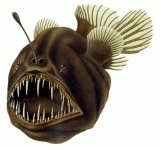
Aggressive mimicry
Encyclopedia

Predation
In ecology, predation describes a biological interaction where a predator feeds on its prey . Predators may or may not kill their prey prior to feeding on them, but the act of predation always results in the death of its prey and the eventual absorption of the prey's tissue through consumption...
, parasites or parasitoid
Parasitoid
A parasitoid is an organism that spends a significant portion of its life history attached to or within a single host organism in a relationship that is in essence parasitic; unlike a true parasite, however, it ultimately sterilises or kills, and sometimes consumes, the host...
s share similar signals
Signalling theory
Within evolutionary biology, signalling theory is a body of theoretical work examining communication between individuals. The central question is when organisms with conflicting interests should be expected to communicate "honestly"...
with a harmless model, allowing them to avoid being correctly identified by their prey or host
Host (biology)
In biology, a host is an organism that harbors a parasite, or a mutual or commensal symbiont, typically providing nourishment and shelter. In botany, a host plant is one that supplies food resources and substrate for certain insects or other fauna...
. In its broadest sense, it involves any type of exploitation, such as an orchid exploiting a male insect by mimicking a sexually receptive female (see pseudocopulation
Pseudocopulation
Pseudocopulation describes behaviors similar to copulation that serve a reproductive function for one or both participants but do not involve actual sexual union between the individuals. It is most generally applied to a pollinator attempting to copulate with a flower. Some flowers mimic a...
), but will here be restricted to forms of exploitation involving feeding. The alternative term Peckhamian mimicry (after George and Elizabeth Peckham
George and Elizabeth Peckham
George Williams Peckham and Elizabeth Maria Gifford Peckham were early American teachers, taxonomists, ethologists, arachnologists, and entomologists, specializing in animal behavior and in the study of jumping spiders and wasps.-Lives and careers:George Peckham was born in Albany,...
) has also been suggested, but it is seldom used. The metaphor of a wolf in sheep's clothing
The Wolf in Sheep's Clothing
A Wolf in Sheep's Clothing is an idiom of Biblical origin. It is used of those playing a role contrary to their real character, with whom contact is dangerous. As a fable it has been falsely credited to Aesop and the theme is now numbered 451 in the Perry Index...
can be used as an analogy, but with the caveat that mimics are not intention
Intention
Intention is an agent's specific purpose in performing an action or series of actions, the end or goal that is aimed at. Outcomes that are unanticipated or unforeseen are known as unintended consequences....
ally deceiving their prey. For example, indigenous Australians
Indigenous Australians
Indigenous Australians are the original inhabitants of the Australian continent and nearby islands. The Aboriginal Indigenous Australians migrated from the Indian continent around 75,000 to 100,000 years ago....
who dress up as and imitate kangaroo
Kangaroo
A kangaroo is a marsupial from the family Macropodidae . In common use the term is used to describe the largest species from this family, especially those of the genus Macropus, Red Kangaroo, Antilopine Kangaroo, Eastern Grey Kangaroo and Western Grey Kangaroo. Kangaroos are endemic to the country...
s when hunting
Hunting
Hunting is the practice of pursuing any living thing, usually wildlife, for food, recreation, or trade. In present-day use, the term refers to lawful hunting, as distinguished from poaching, which is the killing, trapping or capture of the hunted species contrary to applicable law...
would not be considered aggressive mimics, nor would a human angler
Angling
Angling is a method of fishing by means of an "angle" . The hook is usually attached to a fishing line and the line is often attached to a fishing rod. Fishing rods are usually fitted with a fishing reel that functions as a mechanism for storing, retrieving and paying out the line. The hook itself...
. Treated separately is molecular mimicry
Molecular mimicry
Molecular mimicry is defined as the theoretical possibility that sequence similarities between foreign and self-peptides are sufficient to result in the cross-activation of autoreactive T or B cells by pathogen-derived peptides...
, which also shares some similarity; for instance a virus
Virus
A virus is a small infectious agent that can replicate only inside the living cells of organisms. Viruses infect all types of organisms, from animals and plants to bacteria and archaea...
may mimic the molecular properties of its host, allowing it access to its cells.
Aggressive mimicry is opposite in principle to defensive mimicry, where the mimic generally benefits from being treated as harmful. The mimic may resemble its own prey, or some other organism which is beneficial or at least not harmful to the prey. The model, i.e. the organism being 'imitated', may experience increased or reduced fitness
Fitness (biology)
Fitness is a central idea in evolutionary theory. It can be defined either with respect to a genotype or to a phenotype in a given environment...
, or may not be affected at all by the relationship. On the other hand, the signal receiver inevitably suffers from being tricked, as is the case in most mimicry complexes.
Aggressive mimicry often involves the predator employing signals which draw its potential prey towards it, a strategy which allows predators to simply sit and wait for prey to come to them. The promise of food or sex
Mating
In biology, mating is the pairing of opposite-sex or hermaphroditic organisms for copulation. In social animals, it also includes the raising of their offspring. Copulation is the union of the sex organs of two sexually reproducing animals for insemination and subsequent internal fertilization...
are most commonly used as lures. However, this need not be the case; as long as the predator's true identity is concealed, it may be able to approach prey more easily than would otherwise be the case. In terms of species involved, systems may be composed of two or three species; in two-species systems the signal receiver, or "dupe", is the model.
In terms of the visual
Visual system
The visual system is the part of the central nervous system which enables organisms to process visual detail, as well as enabling several non-image forming photoresponse functions. It interprets information from visible light to build a representation of the surrounding world...
dimension, distinction between aggressive mimicry and camouflage
Camouflage
Camouflage is a method of concealment that allows an otherwise visible animal, military vehicle, or other object to remain unnoticed, by blending with its environment. Examples include a leopard's spotted coat, the battledress of a modern soldier and a leaf-mimic butterfly...
is not always clear. Authors such as Wickler have emphasized the significance of the signal to its receiver as delineating mimicry from camouflage. However, it is not easy to assess how 'significant' a signal may be for the dupe, and the distinction between the two can thus be rather fuzzy. Mixed signals may also be employed. Aggressive mimics often have a specific part of the body sending a deceptive signal, with the rest being hidden or camouflaged.
Comparison with other forms of mimicry

Batesian mimicry
Batesian mimicry is a form of mimicry typified by a situation where a harmless species has evolved to imitate the warning signals of a harmful species directed at a common predator...
and Müllerian
Müllerian mimicry
Müllerian mimicry is a natural phenomenon when two or more harmful species, that may or may not be closely related and share one or more common predators, have come to mimic each other's warning signals...
forms of mimicry, where the mimic shares outward characteristics with an aposematic
Aposematism
Aposematism , perhaps most commonly known in the context of warning colouration, describes a family of antipredator adaptations where a warning signal is associated with the unprofitability of a prey item to potential predators...
or harmful model. In Batesian mimicry, the mimic is modeled on a dangerous (usually unpalatable) species, while in Müllerian mimicry both species are harmful, and act as comimics, converging on a common set of signals and sharing the burden of 'educating' their predators. Also included in defensive mimicry is the lesser known Mertensian mimicry, where the mimic is more harmful than the model, and Vavilovian mimicry
Vavilovian mimicry
Vavilovian mimicry is a form of mimicry in plants where a weed comes to share one or more characteristics with a domesticated plant through generations of artificial selection. It is named after Nikolai Vavilov, a prominent Russian plant geneticist who identified the centres of origin of...
, where weed
Weed
A weed in a general sense is a plant that is considered by the user of the term to be a nuisance, and normally applied to unwanted plants in human-controlled settings, especially farm fields and gardens, but also lawns, parks, woods, and other areas. More specifically, the term is often used to...
s come to mimic crops through unintentional artificial selection. In defensive mimicry, the mimic benefits by avoiding a harmful interaction with another organism that would be more likely to take place without the deceptive signals employed. Harmful interactions might involve being eaten, or pulled out of the ground as a weed. In contrast, the aggressive mimic benefits from an interaction that would be less likely to take place without the deception, at the expense of its target. However, it is important to note that there are other forms of mimicry that are described by the previous sentence, which are not aggressive mimicry—flowers exploiting a pollinator with deceptive signals, for example. There is no analogous word that encompasses all such cases of mimicry, however (see Pasteur, 1982 for a review of classification).
Luring prey
In some cases the signal receiver is lured toward the mimic. This involves mimicry of a resource that is often vital to the prey's survival (or more precisely, the survival of its geneGene
A gene is a molecular unit of heredity of a living organism. It is a name given to some stretches of DNA and RNA that code for a type of protein or for an RNA chain that has a function in the organism. Living beings depend on genes, as they specify all proteins and functional RNA chains...
s) such as nutrition or a mate. If the bait offered is of little value to prey they would not be expected to take such a risk. For example in all known cases of sexual signal mimicry it is always the male sex
Sex
In biology, sex is a process of combining and mixing genetic traits, often resulting in the specialization of organisms into a male or female variety . Sexual reproduction involves combining specialized cells to form offspring that inherit traits from both parents...
that is deceived (in fact, it has been suggested that females of some species have evolved mimicry as a strategy to avoid unwanted matings
Sexual conflict
Sexual conflict occurs when the two sexes have conflicting optimal fitness strategies concerning reproduction, particularly the mode and frequency of mating, leading to an evolutionary arms race between males and females. The conflict encompasses the actions and behaviors of both sexes to influence...
). In these cases the predator need not move about foraging
Foraging
- Definitions and significance of foraging behavior :Foraging is the act of searching for and exploiting food resources. It affects an animal's fitness because it plays an important role in an animal's ability to survive and reproduce...
for prey, but may simply stay still and allow prey to come to it.
Some studies suggest that the Northern Shrikes (Lanius excubitor) sings in winter often imitating small passerines that may be preyed upon when lured within reach.
There has been one report of a margay
Margay
The Margay is a spotted cat native to Middle and South America. Named for Prince Maximilian of Wied-Neuwied, it is a solitary and nocturnal animal that prefers remote sections of the rainforest. Although it was once believed to be vulnerable to extinction, the IUCN now lists it as "Near Threatened"...
using mimicry of the cry of an infant pied tamarin to try to lure an adult tamarin within striking distance.
Food as an attractant
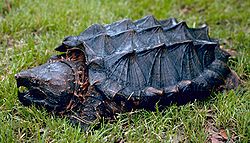
Alligator Snapping Turtle
The alligator snapping turtle is one of the largest freshwater turtles in the world. It is not closely related to, but is often associated with the common snapping turtle. They are the sole living member of the genus Macrochelys--while common snappers are in the genus Chelydra...
(Macrochelys temminckii) is a well-camouflaged ambush predator
Ambush predator
Ambush predators or sit-and-wait predators are carnivorous animals that capture prey by stealth or cunning, not by speed or necessarily by strength. These organisms usually hide motionless and wait for prey to come within striking distance. They are often camouflaged, and may be solitary...
. Its tongue bears a conspicuous pink extension that resembles a worm
Worm
The term worm refers to an obsolete taxon used by Carolus Linnaeus and Jean-Baptiste Lamarck for all non-arthropod invertebrate animals, and stems from the Old English word wyrm. Currently it is used to describe many different distantly-related animals that typically have a long cylindrical...
and can be wriggled around; fish that try to eat the "worm" are themselves eaten by the turtle. Similarly, some snakes employ caudal luring
Caudal luring
Caudal luring is the use of tail movements employed by a predator to attract prey animals. It is a form of mimicry classified formally as aggressive mimicry, but perhaps better described by the term feeding mimicry. The behavior is employed by a number of snake species and allegedly by two lizards,...
(tail luring) to entice small vertebrates into striking range.

Spider
Spiders are air-breathing arthropods that have eight legs, and chelicerae with fangs that inject venom. They are the largest order of arachnids and rank seventh in total species diversity among all other groups of organisms...
s, both in luring prey and stealthily approaching predators. One case is the Golden Orb Weaver (Nephila clavipes), which spins a conspicuous golden colored web in well-lit areas. Experiments show that bees are able to associate the webs with danger when the yellow pigment is not present, as occurs in less well-lit areas where the web is much harder to see. Other colors were also learned and avoided, but bees seemed least able to effectively associate yellow pigmented webs with danger. Yellow is the color of many nectar bearing flowers, however, so perhaps avoiding yellow is not worth while. Another form of mimicry is based not on color but pattern. Species such as Argiope argentata
Argiope argentata
Argiope argentata is a member of the Argiope genus of spiders and is also known as the Silver Argiope.-Description:As with most members of the Argiope genus the female of the species tends to be much larger than the male...
employ prominent patterns in the middle of their webs, such as zigzags. These may reflect ultraviolet
Ultraviolet
Ultraviolet light is electromagnetic radiation with a wavelength shorter than that of visible light, but longer than X-rays, in the range 10 nm to 400 nm, and energies from 3 eV to 124 eV...
light, and mimic the pattern seen in many flowers known as nectar guide
Nectar guide
Nectar guides are patterns seen in some species of flowers, guiding pollinators to their rewards. Rewards commonly take the form of nectar, pollen, or both, but various plants produce oil, resins, scents, or waxes...
s. Spiders change their web day to day, which can be explained by bee's ability to remember web patterns. Bees are able to associate a certain pattern with a spatial location, meaning the spider must spin a new pattern regularly or suffer diminishing prey capture.
Spiders can also be the prey of aggressive mimics. The assassin bug Stenolemus bituberus
Stenolemus bituberus
Stenolemus bituberus is a species of thread-legged insect found across much of Australia. This species spends nearly its entire life in spider webs. It preys upon a variety of spiders, including webs and nests of spiders of Achaearanea, Badumna, Pholcus, and Stiphidion, and the families...
preys on spiders, entering their web and plucking its silk threads until the spider approaches. This vibrational aggressive mimicry matches a general pattern of vibrations which spiders treat as prey, having a similar temporal structre and amplitude to leg and body movements of typical prey caught in the web.
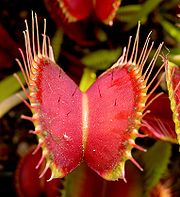
Plant
Plants are living organisms belonging to the kingdom Plantae. Precise definitions of the kingdom vary, but as the term is used here, plants include familiar organisms such as trees, flowers, herbs, bushes, grasses, vines, ferns, mosses, and green algae. The group is also called green plants or...
s are better known for defensive mimicry, there are exceptions. For example, many flowers use mimicry to attract pollinators, while others may trick insects into dispersing their seeds. Nonetheless, most mimicry occurring in plants (for an overview see Wiens, 1978) would not be classified as aggressive, as although luring pollinators etc. is similar to cases above, they are certainly not eaten by the plant. However some carnivorous plant
Carnivorous plant
Carnivorous plants are plants that derive some or most of their nutrients from trapping and consuming animals or protozoans, typically insects and other arthropods. Carnivorous plants appear adapted to grow in places where the soil is thin or poor in nutrients, especially nitrogen, such as acidic...
s may be able to increase their rate of capture through mimicry. For example, some have patterns in the ultraviolet region of the electromagnetic spectrum
Electromagnetic spectrum
The electromagnetic spectrum is the range of all possible frequencies of electromagnetic radiation. The "electromagnetic spectrum" of an object is the characteristic distribution of electromagnetic radiation emitted or absorbed by that particular object....
, much like the spider webs described above.
Aggressive mimicry involving two species
Mimicry systems involving only two species are known as bipolar. Only one bipolar arrangement is possible here: that where the dupe is itself the model. There are two such variants on this arrangement of mimic imitating its target, in the first case, termed Batesian-Wallacian mimicry after Henry Walter BatesHenry Walter Bates
Henry Walter Bates FRS FLS FGS was an English naturalist and explorer who gave the first scientific account of mimicry in animals. He was most famous for his expedition to the Amazon with Alfred Russel Wallace in 1848. Wallace returned in 1852, but lost his collection in a shipwreck...
and Alfred Russell Wallace, the model is the prey species. Similarly, the model is the host of a brood parasite
Brood parasite
Brood parasites are organisms that use the strategy of brood parasitism, a kind of kleptoparasitism found among birds, fish or insects, involving the manipulation and use of host individuals either of the same or different species to raise the young of the brood-parasite...
in the second such case.
Batesian-Wallacian
In some cases of Batesian-Wallacian mimicry, the model is a sexually receptive female, which provides a strong attractive effect on males. Some spiders use chemical rather than visual means to ensnare prey. Female bolas spiders of the genus Mastophora allure male moths by producing analogues of the moth species' sex pheromones. Each species of spider appears to specializeGeneralist and specialist species
A generalist species is able to thrive in a wide variety of environmental conditions and can make use of a variety of different resources . A specialist species can only thrive in a narrow range of environmental conditions or has a limited diet. Most organisms do not all fit neatly into either...
in a particular species of prey in the family Psychodidae
Psychodidae
The nematoceran family Psychodidae are small true flies with short, hairy bodies and wings giving them a "furry" moth-like appearance...
. Juveniles use their front pair of legs to capture prey, such as flies
Fly
True flies are insects of the order Diptera . They possess a pair of wings on the mesothorax and a pair of halteres, derived from the hind wings, on the metathorax...
. Older spiders use a different strategy however, swinging a sticky ball known as a bolas suspended by a silk thread at moths. But both old and juvenile are able to lure prey items via this olfactory signal; even young spiderlings have been shown to attract prey species.
Beginning in the 1960s, James E. Lloyd's investigation of female fireflies
Firefly
Lampyridae is a family of insects in the beetle order Coleoptera. They are winged beetles, and commonly called fireflies or lightning bugs for their conspicuous crepuscular use of bioluminescence to attract mates or prey. Fireflies produce a "cold light", with no infrared or ultraviolet frequencies...
of the genus Photuris
Photuris (genus)
Photuris is a genus of fireflies wherein are the femme fatale fireflies of North America. This common name refers to the fact that the females of these predatory beetles mimic the light signals of other firefly species' males, to attract, kill, and eat them...
revealed they emit the same light signals that females of the genus Photinus use as a mating signal. Further research showed male fireflies from several different genera
Genus
In biology, a genus is a low-level taxonomic rank used in the biological classification of living and fossil organisms, which is an example of definition by genus and differentia...
are attracted to these mimics, and are subsequently captured and eaten. Female signals are based on that received from the male, each female having a repertoire of signals matching the delay and duration of the female of the corresponding species. This mimicry may have evolved from non-mating signals that have become modified for predation.
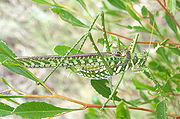
Host mimicry by brood parasites
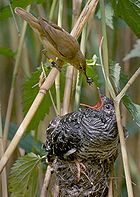
Kleptoparasitism
Kleptoparasitism or cleptoparasitism is a form of feeding in which one animal takes prey or other food from another that has caught, collected, or otherwise prepared the food, including stored food...
where the mother has its offspring raised by another unwitting organism, is one such situation where host-parasite mimicry has evolved. Pasteur terms this form of aggressive-reproductive mimicry Kerbyan mimicry, after the English entomologist
Entomology
Entomology is the scientific study of insects, a branch of arthropodology...
William Kirby.
Mimicry of mutualistic species

The former situation has been termed Wicklerian-Eisnerian mimicry. This involves the mimic resembling a species that is an important partner of the dupe, whether they live together
Symbiosis
Symbiosis is close and often long-term interaction between different biological species. In 1877 Bennett used the word symbiosis to describe the mutualistic relationship in lichens...
or not. A case of the latter situation is a species of cleaner fish
Cleaner fish
Cleaner fish are fish that provide a service to other fish species by removing dead skin and ectoparasites. This is an example of mutualism, an ecological interaction that benefits both parties involved. A wide variety of fishes have been observed to display cleaning behaviors including wrasses,...
and its mimic, though in this example the model is greatly disadvantaged by the presence of the mimic. Cleaner fish are the allies of many other species, which allow them to eat their parasites and dead skin. Some allow the cleaner to venture inside their body to hunt these parasites. However, one species of cleaner, the Bluestreak cleaner wrasse
Bluestreak cleaner wrasse
The bluestreak cleaner wrasse is one of several species of cleaner wrasse found on coral reefs in the Indian Ocean and much of the Pacific Ocean, as well as many seas, including the Red Sea and those around Southeast Asia...
(Labroides dimidiatus), is the unknowing model of a mimetic species, the Sabre-toothed blenny
Sabre-toothed blenny
The sabre-toothed blenny, Aspidontus taeniatus, is a species of blenny that mimics the "dance" of Labroides dimidiatus; a similarly colored species of cleaner wrasse. It tricks fish into offering their underparts to be cleaned. Instead of eating parasites from the scales of the fish, the...
(Aspidontus taeniatus). This wrasse
Wrasse
The wrasses are a family, Labridae, of marine fish, many of which are brightly colored. The family is large and diverse, with over 600 species in 82 genera, which are divided into nine subgroups or tribes....
, shown to the left cleaning a grouper
Grouper
Groupers are fish of any of a number of genera in the subfamily Epinephelinae of the family Serranidae, in the order Perciformes.Not all serranids are called groupers; the family also includes the sea basses. The common name grouper is usually given to fish in one of two large genera: Epinephelus...
of the genus Epinephelus
Epinephelus
Epinephelus is a genus of groupers. They are large sea fish. Members of this genus may also be called a Mero.-Species:FishBase lists 99 species:* Areolate grouper, Epinephelus areolatus ....
, resides in coral reef
Coral reef
Coral reefs are underwater structures made from calcium carbonate secreted by corals. Coral reefs are colonies of tiny living animals found in marine waters that contain few nutrients. Most coral reefs are built from stony corals, which in turn consist of polyps that cluster in groups. The polyps...
s in the Indian and the Pacific Oceans, and is recognized by other fishes who then allow it to clean them. Its imposter, a species of blenny, lives in the Indian Ocean
Indian Ocean
The Indian Ocean is the third largest of the world's oceanic divisions, covering approximately 20% of the water on the Earth's surface. It is bounded on the north by the Indian Subcontinent and Arabian Peninsula ; on the west by eastern Africa; on the east by Indochina, the Sunda Islands, and...
and not only looks like it in terms of size and coloration, but even mimics the cleaner's 'dance'. Having fooled its prey into letting its guard down, it then bites it, tearing off a piece of its fin before fleeing the scene. Fish grazed
Grazing
Grazing generally describes a type of feeding, in which a herbivore feeds on plants , and also on other multicellular autotrophs...
upon in this fashion soon learn to distinguish mimic from model, but because the similarity is close between the two they become much more cautious of the model as well, such that both are affected. Due to victim's ability to discriminate between foe and helper, the blennies have evolved close similarity, right down to the regional level.
Cryptic aggressive mimicry
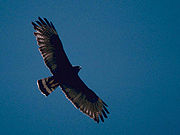
Another case is cryptic mimicry, where the predator mimics an organism that its prey is indifferent to. Unlike in all cases above, the host is ignored by prey, allowing it to avoid detection until prey are close enough to strike. This is in principle very similar to camouflage, and is known as mimesis. The Zone-tailed Hawk
Zone-tailed Hawk
The Zone-tailed Hawk is a medium-sized hawk of warm, dry parts of the Americas. It feeds on small vertebrates of all kinds , including birds up to the size of quail....
(Buteo albonotatus), which resembles the Turkey Vulture
Turkey Vulture
The Turkey Vulture is a bird found throughout most of the Americas. It is also known in some North American regions as the Turkey Buzzard , and in some areas of the Caribbean as the John Crow or Carrion Crow...
(Cathartes aura), may provide one such example. It flies amongst them, suddenly breaking from the formation and ambushing its prey. Here the hawk's presence is of no evident significance to the vultures, affecting them neither negatively or positively. There is some controversy over whether this is a true case of mimicry.
Parasites mimicking host prey
Some of the predators described above have a feature that lures prey, and likewise some parasites mimic their host's natural prey, but in this case the roles are reversed; the parasite gets eaten by the host. This deception provides the parasite easy entry into the host, which they can then feed upon, allowing them to continue their life cycle. Researchers may be able to predict the host of such parasites based on their appearance and behavior.One such case is a genus of shellfish, Lampsilis
Lampsilis
Lampsilis is a genus of freshwater mussels, aquatic bivalve mollusks in the family Unionidae,the river mussels.- Species within the genus Lampsilis:* pink mucket * lined pocketbook...
, which feeds on the gill
Gill
A gill is a respiratory organ found in many aquatic organisms that extracts dissolved oxygen from water, afterward excreting carbon dioxide. The gills of some species such as hermit crabs have adapted to allow respiration on land provided they are kept moist...
s of fish in the larval stage of their development. Once they mature, they leave the fish as adult mollusc. Gaining entry into the host is not an easy task though, despite the fact that several hundred thousand larvae are released at once. This is especially the case in flowing water bodies such as streams, where they cannot lie on the substrate and wait to be taken up in the course of foraging. Female shellfish have evolved a special technique for delivering their offspring into a suitable host, however. Structures on the edge of the mantle are able to capture the interest of fish. Some resemble small fish themselves, with eye spots, a 'tail' and horizontal stripes, and may even move in a similar fashion, as if facing the current (rheotaxis
Rheotaxis
Rheotaxis is a form of taxis seen in many aquatic organisms, e.g., fish, whereby they will turn to face into an oncoming current...
). When overshadowed by a fish, the larvae are forcefully expelled, becoming ectoparasites on their unsuspecting host.
Cercaria mirabilis, a trematode, has an especially large larval stage (known as a cercaria) which looks much like a small crustacean or mosquito larva. It also mimics the locomotory
Animal locomotion
Animal locomotion, which is the act of self-propulsion by an animal, has many manifestations, including running, swimming, jumping and flying. Animals move for a variety of reasons, such as to find food, a mate, or a suitable microhabitat, and to escape predators...
behavior of such animals, allowing it to be eaten by predaceous fish.
Another parasitic trematode example is seen in a terrestrial setting. Leucochloridium
Leucochloridium
Leucochloridium is genus of parasitic worms.-Species:Species in the genus Leucochloridium include:* Leucochloridium caryocatactis * Leucochloridium fuscostriatum Robinson, 1948...
is a genus of flatworm
Flatworm
The flatworms, known in scientific literature as Platyhelminthes or Plathelminthes are a phylum of relatively simple bilaterian, unsegmented, soft-bodied invertebrate animals...
(phylum Platyhelminthes) which matures in the intestine of songbird
Songbird
A songbird is a bird belonging to the suborder Passeri of the perching birds . Another name that is sometimes seen as scientific or vernacular name is Oscines, from Latin oscen, "a songbird"...
s. Their eggs pass out of the bird in the feces
Feces
Feces, faeces, or fæces is a waste product from an animal's digestive tract expelled through the anus or cloaca during defecation.-Etymology:...
and are then taken in by Succinea
Succinea
Succinea, common name amber snails, is a genus of small, air-breathing, land snails, terrestrial pulmonate gastropod molluscs in the family Succineidae.They usually live in damp habitats such as marshes.-Species:...
, a terrestrial snail that lives in moist environments. The eggs develop into larvae inside this intermediate host
Intermediate host
A secondary host or intermediate host is a host that harbors the parasite only for a short transition period, during which some developmental stage is completed. For trypanosomes, the cause of sleeping sickness, humans are the primary host, while the tsetse fly is the secondary host...
, and then must find their way into the digestive system of a suitable bird. The problem here is that these birds do not eat snails, so the sporocyst must find some way of manipulating its future host into eating it. Unlike related species, these parasites are brightly colored and able to move in a pulsating manner. A sporocyst sac forces its way into the snail's eye stalks, and pulsates at high speed, enlarging the tentacle in the process. It also affects the host's behavior: the snail moves towards light, which it usually avoids. These combined factors make the sporocysts highly conspicuous, such that they are soon eaten by a hungry songbird. The snail then regenerates its tentacles, and Leucochloridium carries on with its life cycle.
Further reading
- Wickler, W.Wolfgang WicklerWolfgang Wickler is a German zoologist, behavioral researcher and publicist. As of 1974, he led the ethological department of the Max Planck Institute for Behavioral Physiology in Seewiesen near Starnberg and he took over as director of the institute in 1975...
(1968) Mimicry in Plants and Animals (Translated from the German) McGraw-Hill, New York. ISBN 0-07-070100-8. Pages 123-220 discuss aggressive mimicry. - Nicolai, J. (1974) Mimicry in parasitic birds. Scientific American 231 :93-98.
External links
- Feeding behavior of the frogfishes (Antennariidae) Description, images and video of aggressive mimicry in frogfishFrogfishFrogfishes, family Antennariidae, are a type of anglerfish in the order Lophiiformes. They are known as anglerfishes in Australia, where 'frogfish' refers to a different type of fish...
. - Acoustic aggressive mimicry of cicadas by an Australian predatory katydid..

